NOTE: Manila-Bicol trips are currently suspended due to ongoing repairs. For updates on operations, visit the PNR Website.
“I am on the top bunk of a sleeper coach aboard the Bicol Express making its way from Naga to Manila. There’s something very nostalgic about the rocking motion of the train chugging along noisily on the tracks. I find the rhythmic vibrations of the train’s engine, sounds of metal clanging on metal, and echoes of ‘choo-choo’ of the train’s horn oddly comforting.” – excerpt from travel journal written on train 11/3/11 before lights were switched off
My sister and I were little kids the last time we rode the Bicol Express of the Philippine National Railways (PNR) with our parents. My mother says I first traveled by train when I was two months old. She managed to carry my sister (then 2 years old) and I along with all our luggage. Throughout our childhood, we would take the train frequently to shuttle back and forth from our home province Naga to Manila, to spend summers and Christmases with my grandparents and other relatives.
My maternal grandparents would pick us up at Paco Station (which my sister recalls was a grand-looking place with a winding set of stairs that didn’t lead anywhere) in Manila after the 10-hour ride. During the early 1980s, I remember the train being a more popular means of transport because of the bad roads which buses plied going to Bicol. When the roads improved, traveling by bus became more convenient. Airlines also offered flights to Naga, so we stopped riding the train altogether until the trips were discontinued. Lack of maintenance, emergence of informal settlers living along the tracks who would steal the wooden planks and metal rails, and damage to the railway network due to typhoons were just a few of the reasons why the trips eventually stopped.
Earlier this year, when I heard that the Bicol Express would resume operations again, I immediately wanted to try it out. After several failed attempts to ride the train on my own since it relaunched (work and travel conflicts, trips temporarily discontinued due to system maintenance, and then cancelled due to typhoons, etc.), I finally got to board the train again with my whole family. My sister had spent the sem break in Naga with her son Eli and she was heading back with my parents to Manila for a visit so they booked a sleeper cabin. The night before they were scheduled to leave, I hopped on a bus to Naga just so that I could ride on the train with them on the way back. We were all excited since it would be my nephew’s first train ride.
The trip brought back memories of our own childhood rides and from my father, who rode the train as a child himself, in the 1950s. Back then, he says that the windows of the train were open and you could stick your head out and wave to people outside, just like the Hogwarts Express in the Harry Potter movies. Now, clear sturdy glass covers all the large windows, protected by metal screen grates since people living along the tracks continue to throw stones and rocks every time the train passes by.
Dante David, one of the train conductors, who we got to have a nice nice chat with during our ride told us that despite this, two of the windows had already been damaged because people living along the tracks hurled large rocks against the windows. He remarked how only trains in the Philippines needed to be fitted with these kind of grates to ensure that passengers inside wouldn’t get hurt. Since this would often happen at night and the train was on a strict schedule, they couldn’t just stop anytime to apprehend the people.
I vaguely remember that the old sleeping berths were somewhat dark, enclosed, and each cabin had a metal door. The family sleeper coaches now are pretty clean and comfortable. The orange cushioned beds in the lower bunks double as seats while a small ladder covering the window leads up to the top bunks. One cabin is ideal for a group or family of four, but if you’re traveling alone, you can draw the curtains surrounding each individual bed to have some privacy. There are about three sleeper coaches, each with a 30-passenger capacity, and another coach with reclining seats that can seat 60 passengers. The conductor shared that there’s also a dining cart and executive suite coach (with more private cabins), which they used during the fiesta. However, both dining and executive carts are not used during normal trips.
I remember the bathrooms in the old train being small metal rooms towards the back of the cabin where you could actually see the train tracks and gravel if you looked down the toilet. Now, the train is fitted with modern amenities with several sinks towards the end of the coach and separate flush-toilets for male and female passengers.
My mom shared that when we were kids, whenever a train broke down, we had to get down and ride wooden rail skates to transfer to another train at another stop. There were times when the drivers of the skates would stop to feel the train tracks for vibrations and suddenly make everyone get off with their baggage. They would lift the entire wooden contraption off the train tracks so that a train going in the other direction could pass. Thankfully, nothing like that happened this time, and our ride was smooth and on schedule.
Eli was interested in everything, and wanted to keep climbing up and down the beds. He also made a game of swaying back and forth in the middle of the two lower bunk beds to purposely fall into someone’s arms. Unlike traveling by bus or airplane, the sleeper coaches offered more space for him to move around and play, and it was nice to be able to lounge about and lie down properly. Ticket prices for the train that what you would normally spend on airfare. After enjoying our packed dinner of burgers from Bigg’s, we spent most of the ride reminiscing about our early train rides, keeping Eli entertained, and playing our staple road games. This time we chose to list songs that had anything to do with journeys and traveling in general.
When Eli finally fell asleep, the rest of us settled down in our own bunks to get some rest. If you’re not used to bus rides or suffer from carsickness, I recommend you stay on the lower bunks, because the swaying is much rougher at the top bunks. There were times in the night I was jerked awake when the train would swerve violently. Lights were turned on again at about 4:00 am and we got ready to get down at Pasay Road (formerly Pio del Pilar), a very tiny station in contrast to the grand Paco station.
All in all, it was a very worthwhile trip and I was glad I got to experience it with my family again after so many years. If you’re planning to go to Bicol anytime soon, I’d recommend you take this on your way there or back to make your journey an added adventure as well.
TRAVEL TIPS
- Thanks to Ironwulf’s review of the Bicol Express’ soft-opening ride, I was able to warn my family that no blankets and pillows would be provided. All of the sleeper cabins are fully air-conditioned, so comfortable warm clothes, jackets, socks and blankets are a must.
- If you don’t have a pillow, you can always make a makeshift pillow from your bag of clothes.
- Dining carts are not yet operational, so eat ahead or bring food to have dinner on board. Train staff have converted a broom closet at the end of the coaches into a small store where they sell water, chips, light snacks and coffee.
- The train stops for a maximum of one-two minutes per station for people to get on and off, so double check all your luggage, and be ready to get down quickly.
- Make use of the one-two minute stops to go to the restroom so that it’s not so shaky.
- Lights are turned off at 10:00 pm so people can rest and are turned on again at around 4:00 am to wake people up. The private nightlights per berth don’t seem to work, so it helps to have a flashlight if you want to read.
- The last stop in Manila is Tutuban Station. Make sure to reserve your hotel in Manila online, that way you know where to go once you arrive. There are also stops at Alabang and Pasay Road (formerly Pio del Pilar). Departure from Pasay Road to Naga is 6:57 pm.
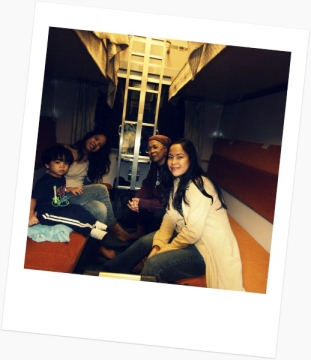 The ticketing system is still not yet that organized and passengers can only buy their ticket on the day of departure itself. Trains were fully booked during the Penafrancia Fiesta and All Soul’s Day weekend, but they normally have extra seats/sleepers on normal days.
The ticketing system is still not yet that organized and passengers can only buy their ticket on the day of departure itself. Trains were fully booked during the Penafrancia Fiesta and All Soul’s Day weekend, but they normally have extra seats/sleepers on normal days.- You can try calling beforehand to make reservations but we found it really difficult to call PNR’s listed number. In Naga, it was easy enough to just go to the station and buy the tickets. I’m not sure about the system for the Manila-Naga bound trains.
- Free baggage allowance = 20 kilos per passenger.
- Kids 3 ft. and below are free of charge!
TRAIN SCHEDULE
- Train 612 – NAGA – MANILA (Departure 6:30 pm – Arrival 4:30 am daily)
- Train 611 – MANILA – NAGA (Departure 6:30 pm – Arrival 4:30 am daily)
Source: PNR Facebook Page
*Discounted 30% flat rates as of November 2011
Reserve your seat before boarding. For inquiries, please call:
- Manila/Tutuban – (02) 3190048
- Lucena – (042) 661-2990
- Naga – (054) 698-2132
More photos of train interiors in Travel Up’s FB page.
=====================
 This is my entry to the Pinoy Travel Bloggers’ Blog Carnival for December 2011, with the theme “The Journey” hosted by Travel Up.
This is my entry to the Pinoy Travel Bloggers’ Blog Carnival for December 2011, with the theme “The Journey” hosted by Travel Up.

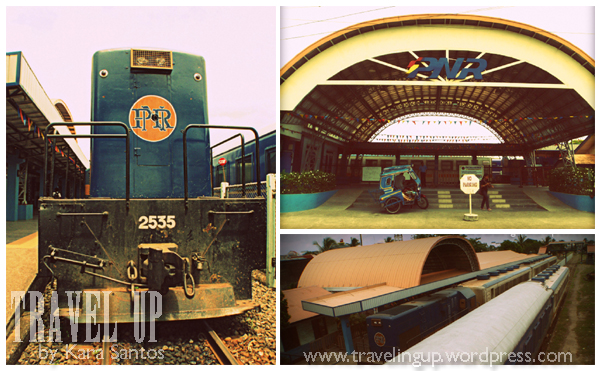


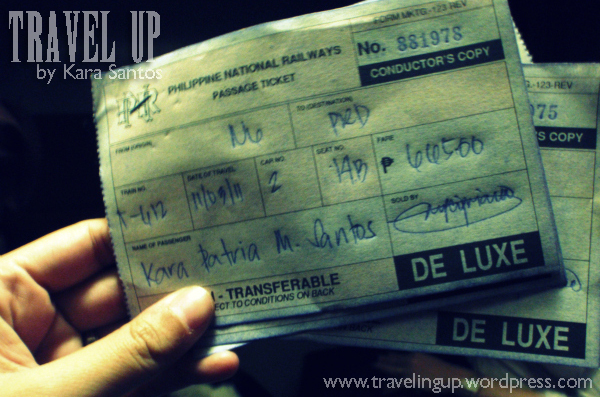

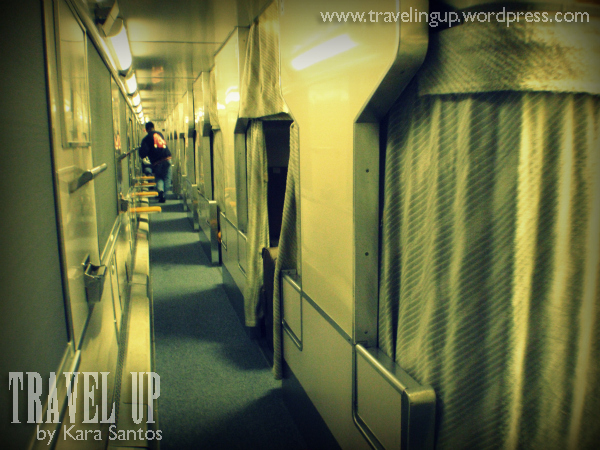
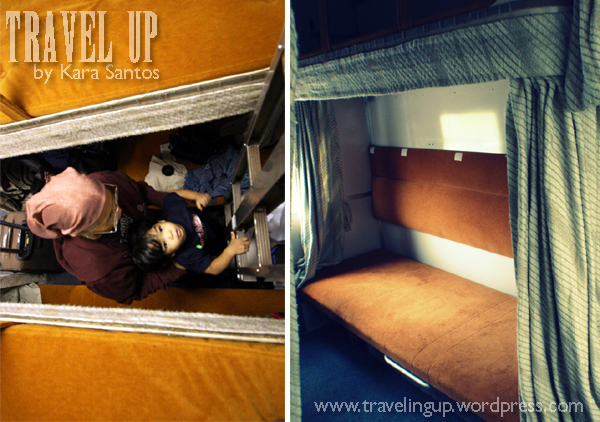
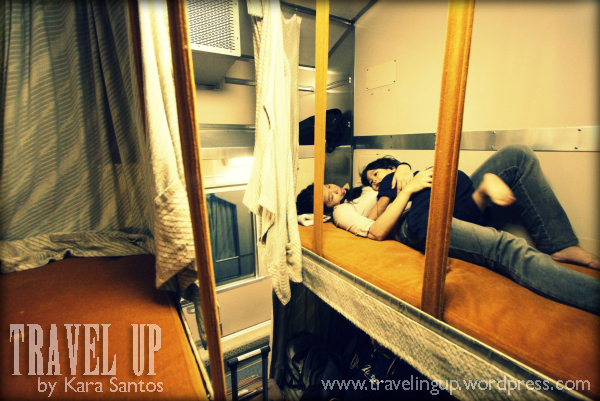



Great tips! Naunahan mo ako. Would love to train to Naga and remember all those train rides I took in the past. Will share this and post on my page. Thanks, kara.
I’m so prepped up for a night inside a sleeper train from Hat Yai, TH to KL, Malaysia until this. Gusto ko i-try ‘to! CWC, we have unfinished business!
Will try this too soon!
honestly, i am afraid to ride on my own but i guess it is worth a try. is it safe for lone traveler?
i’m also from Naga, hope you can visit my blog sometime. thanks.
i also remember my childhood trips on board the train going to Naga to visit my paternal grandparents and hopefully soon i can also bring my daughter there to experience the trip too… the last time she rode a train was when we did the melbourne-sydney-brisbane trip which was more than 6 years ago and she was just 4 years old.
meron plang stop-over sa lucena etal. thanks for the infos! sayang, bumagyo kasi yung dati noh?
I want to try this together with my family. Are the CR’s clean? Worried lang ako baka mahilo mga kids ko during the trip.
Nice experience. The last time I did use the train was when I was in my first year of college in Manila. I wanted to go home for Christmas, no more tickets for the bus and could not afford the plane ticket. I went to Paco and my journey started from there.
Thanks Tita Lili. I hope you and your family enjoy the train ride. 🙂 Ferdz has a very good review of the inaugural train ride earlier this year, which I found useful for our trip. The rates are discounted right now though. It’s even cheaper than the aircon bus.
Haven’t ever tried sleeper trains in other countries! Yung commuter train lang to Ayutthaya from Bangkok, which is similar to the PNR commuter train I think. 🙂
Uy, taga Bicol din. Have fun!
Hi Melandria. I haven’t tried riding alone yet, but it seemed pretty safe to me. There were train conductors patrolling the aisles. If you’re in a sleeper coach, you can draw the curtains so you have more privacy. It’s better than sitting/sleeping next to complete strangers (which I’ve done) when riding a night bus.
Hi Batangala. I think it’s nice that you take your daughter traveling around at such a young age. She’ll really appreciate all the experiences later when on when she’s older. Too bad there are no day trips for this yet, since you can’t really see the scenery outside the train. (P.S. Nagutom ako sa Zugbu Liempo post mo.)
Yup, may quick stopovers dun. I was asking if it’s possible to get to Daet by train (since I still have a pending invitation to go to Calaguas), and the conductor mentioned you can get down in Sipocot and take a bus. Will explore this option further 🙂 Yeah, bumagyo last time nung Camsur Marathon so they cancelled the trip then!
Hi Randy. I posted more photos of the restrooms and train interiors at: http://www.facebook.com/TravelUp. The restrooms are cramped but clean. They look like the CRs aboard buses, if you’ve ever tried riding the LazyBoy or Extreme Sleepers of Isarog and Penafrancia Tours. Medyo nakakahilo yung top bunks at first, but sanayan lang. My nephew didn’t have a problem and was able to sleep pretty well. 🙂 I saw a lot of families with kids as well. Maybe bring Bonamine or anti-dizziness tabs just in case?
Hi Bitang95. Thanks for sharing that. Hopefully, they can maintain the trains so more people can use it regularly. Too bad the Paco station isn’t being used anymore. The one in Pasay Road isn’t very distinctive.
sayang… my family and i took the bus going to naga. we should try this next time. 🙂
I’ve ridden one of those wooden rail skates as a kid too! They even have a system pag nag-meet kayo with another skate, like priority yung may kids, pregnant women or old people na sakay.
Kahit wala naman akong gagawin sa Naga, gusto ko ‘tong sakyan cause never pa kong nakasakay dito!
Also I read somewhere that kailangan triangular yung shape ng roof ng trains natin kasi people who live beside the tracks would throw their garbage.
wow.. ganda na pala ng train ng PNR..:) definitely will try it.
very informative post..we took a bus night trip going to Naga the last time. I’ll definitely try this next year.
What a great trip to rekindle childhood memories. Like you, I’m glad the Bicol Express is up and running again to serve the new generations. Philippines was like among the first few nations to develop a railway system until it get stuck in a rut, its a new day and a reborn for the railway industry. Cheers!
nice….ask q lng….may station sa daet or labo???i want to ride ….tnx
Tamang tama. You can enjoy pa all of the things to do when you’re bored during long transits aboard the train! 🙂
Thanks for the trivia on the priority system for skates. I forgot that! The conductor mentioned that he’s come across passengers who ride the train back and forth just for the experience. It’s really sad though that people still throw garbage and stones.
Enjoy your trip! 🙂
I usually take the night trip on buses when traveling solo. This is a good option if you’re with a group 🙂
Thanks Marky. Let’s hope the railway system can be maintained. In other countries, train systems are so organized and connected. Too bad wala pang dining cars and freight train (yet) so hindi pa pwede isakay motor :p
Hi Maricris. According to the train conductor, to get to Daet, you can get down at the Sipocot station, then ride a bus. I haven’t tried this yet, so I don’t have exact details on where to ride the bus from the train or how much it will cost though. Hope this helps 🙂
Hi Kara,
This article brings me down memory lane. We had only the “Bicol Express” then. In the early 60’s, the ordinary coach was cramped and hot but I always enjoyed my train rides. The announcement of “kape kape kape Hondagua na” was a welcome sound because that would mean a hot glass of coffee with a crisp pan de sal. I remember, there were no plastic cups yet in the train.
Your photos are excellent. This article is a collector’s item.
France
Thanks France. A lot of Bicolanos have been sharing some interesting memories aboard the train. The conductor mentioned how vendors could come on board before selling balut, peanuts, and other snacks and then they would go down in the next station where a new set of vendors would board. They’ve don’t allow this anymore for security reasons and the potential mess. They still sell coffee now but they use styro cups. It’s pretty hard to balance with hot coffee on the train! :p
wow! sana may promo pa din sila ngayon. we’d be heading to caramoan tonight and we’re planning to take the bicol express train back to manila. i’m soooo excited!
Hi Lily, as far as I know the promo rates still apply. Hope you had a great time riding the train back from your Caramoan trip! 🙂
I always wanted to try this again. Like you, I have a very memorable train ride experience. I would always tag along with my parents (or did I insist they tag me along or I would throw a tantrum? Hehe). My route back then was the north rail bound for Nueva Ecija. We normally take the 5:30am trip. And I recall we had an MRT-like coaches even before. white and blue ang color, that replaced the seats that face each other. I should try this one in the near future…perhaps a summer vacay with my sons.
i am yet to experience this… i didn’t know na may stopover/terminal pala sa Lucena? that’s good! thanks for sharing Kara… 🙂
I took the bus ride the last time I went to Camsur..
Now this is interesting, and more like a journey down memory lane for you.
I’ll surely take note of taking a train instead on my next trip to Bicol. 🙂
I didn’t know there used to be a north rail bound for Nueva Ecija. Too bad the train systems here in the country aren’t really operational. It would be really cool to travel all around the country by train 🙂
Yup, meron sa Lucena! Have fun sa train ride, Mervz! 🙂
Yup, I’ve gotten used to riding the night bus to Naga, so riding the train was really a little more interesting 🙂
Can you share your blog here?
http://www.facebook.com/philippinerailways
http://www.facebook.com/groups/philippinerailways/
Hi, Philippine Railways. Thanks for dropping by here. I’ve posted a link to this blog post on your FB wall as requested. More power to PNR! 🙂
Hello,1st time po namin pupunta Naga ng mga friends ko. gusto po namin sana maexperience ung ‘Bicol Express’ since,nakasakay na po kayo, ask ko lang kung yung Family sleeper ba na Php950 is kasya para sa 3 persons? tsaka yung rate na yun, per head ba?
Hi Ran. The Family Sleeper has 2 double deck bunkers na magkaharap, so good for 4 adults yun 🙂 The rate is per head/bunk. P665/head lang sya nung sumakay kami (discounted rate), but I’m not sure kung nag-revert na sa P995 na normal price. For more info, route map, numbers to call, etc. check out PNR’s official FB page: http://www.facebook.com/pnrailways. Enjoy your trip! 🙂
may outlet ba sa room para magcharge?
Would love to try the Bicol Express in the very near future! 🙂 Nagpaplano na kami ng brothers ko this july Godwilling. 🙂 Sana ma-maintain nilang malinis ang train at madagdagan din sana ang train sched (esp day trips para makapag sight seeing na rin. 😀 ) Thanks for sharing Kara! Godbless.
Hi Samiel. Hindi ko napansin kung may sockets to charge phones or gadgets. Parang wala but maybe you can ask sa FB page nila: http://www.facebook.com/pnrailways. I’d suggest mag-charge ka muna bago magbiyahe. Thanks.
Hi Bong. I agree na maganda ang day trip, esp. with dining carts, para feeling “Hogwarts Express”. :p By the way, PNR has extended the train line’s route from Naga to Polangui, Ligao, and Travesia in Albay in case gusto niyo magside trip to Legazpi. Hope you and your brothers have a good trip!
Trains have always fascinated me eversince I first saw them at Lucena City many years ago. My Mom used to tell us that train was “the choice of transportation” for the Lucenahin’s ( native of Lucena ) traveling to Manila during the 50’s and 70’s. when roads to the capital was still largely undeveloped. They were fun stories about how some of the elderly folks would remove their “bakya” ( native wooden shoes ) as they get on the train because they were really overwhelmed by the new experience of riding on those steel horses and that were huge enough to be a house thus the customary shoe removal was said to have been practiced by some star-struck locals. The trains were pretty much instant celebrity to the riding public as people from all walks of life who happened to ride on it or just saw them running by were all captivated by its grandeur and promise. Unfortunately, soon after the south expressways ( that’s how I remembered they were called before it became SLEX of today ), have been extended as far south as Calamba, Lucenahin’s have started to ride the bus more often until the train slowly lose its strong ridership because of the advent of new well paved highways where buses ply their routes much faster than ever before compared to the the trains that also suffered poor maintainance. The dawn of buses as “king of the public transportation” in the southern tagalog region had really come when I recalled as were kids, my siblings were brought by our parents at the train station and we almost got on the train bound for Manila after excitedly waiting for hours only to be told that the train won’t be coming by because it encountered mechanical issues down south.
A few years back, I had a chance to ride the train again when I took Amtrak train that followed the West Coast from San Diego to Seattle. I could say that the ride was an adventure in itself just like the destination was worth it. It occured to me that train rides are a lot of fun and exciting not very much because of it’s speed but more because of its size and the varied scenery from the huge windows. I thought trains are like huge houses or buildings connected to each other on wheels where you could go about many of your routines and rituals that you are used to when at home but this time while you are traveling. Only the unimaginative would be bored when on board the train. I could liken my train experience to ones journey in life, it twists it turns, sometimes it grinds to halt, then it goes up and down, under the rain and sunshine it choo-choo’s forward till you could see the light at the end of the tunnel. I just hope and wish, the trains in the Philippines will make a strong come-back just like its economy and won’t go back again where it was before. Good luck to PNR and let’s enjoy our train ride!
Hi JR, Thanks for taking the time to share those wonderful anecdotes about how the train during the 50s and 70s. There’s really something about trains that bring back this sweeping sense of nostalgia and old-world grandeur. In fact, I heard that a lot of the current passengers ride to rekindle the sense of their first train trip. Your insight on train rides being like life is just brilliant. Thanks! 🙂
I have enjoyed reading the articles on this web site and it brings back memories of my first trips by train.
Being a chap from England my first memories where of boarding a local service to London, which back then was steam hauled, then transfering to the scary world of the London Underground. Well it was scary to a 5 year old. I was also lucky enough to have a line at the top of my road where I lived, and spent many a day waving at the train crews when they passed.
Now 54 years on and I work for a rail company in the UK and enjoy free or discounted travel in the UK and Europe. I did try and get a discount on the LRT in Manila a couple of years back, but all I got was a strange look off the ticket clerk. Well I will be back in the Philippines in December and, with a bit of luck, might be able to get a trip on the PNR.
I would like to echo a previous reply and hope that the Railways in the Philippines will make a strong come back.
Hi Dave. It’s always great to hear the nostalgic stories from people on their first train rides. Thanks fort sharing your story. Unfortunately, I heard that the PNR train to Bicol derailed after heavy rains washed out some of the tracks and is undergoing maintenance. I hope that it’ll be fixed when you visit this December, so you can try it out. Do check out PNR’s official page for updates. http://www.facebook.com/pnrailways
hi,tga manila kami and want to try this with my three kids and wife, kaso wala kami idea kung saan kami papasyal..magkano budget,etc…